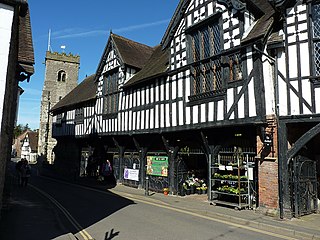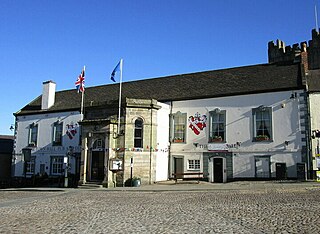
Beverley is a market town and civil parish in the East Riding of Yorkshire, England. It is located 27 miles (43 km) south-east of York and 6 miles (9.7 km) north-west of Hull. At the 2021 census the built-up area of the town had a population of 30,930, and the smaller civil parish had a population of 18,014. It is the county town of the East Riding of Yorkshire.

Beverley and Holderness is a county constituency in the East Riding of Yorkshire for the House of Commons of the Parliament of the United Kingdom. It elects one Member of Parliament (MP) at least once every five years by the first-past-the-post electoral system. The constituency has been represented by Graham Stuart of the Conservative Party since the 2005 general election.

Totnes Guildhall is a 16th-century Tudor historic guildhall, magistrate's court, and prison, in the town of Totnes, south Devon, in southwest England. It is a Grade I listed building.

The Much Wenlock Guildhall is a guildhall located on Wilmore Street in Much Wenlock, Shropshire. It is a Grade II* listed building.

East Riding of Yorkshire Council is the local authority for the East Riding of Yorkshire, a unitary authority area within the larger ceremonial county of the same name. The council has been under no overall control since 2023, being led by a Conservative minority administration. It is based at County Hall in Beverley.

Cowbridge Town Hall is a public building in the High Street of Cowbridge in South Wales. The town hall, which is the meeting place for Cowbridge with Llanblethian Town Council, and also houses the town clerk's office, the committee rooms and the Cowbridge Museum, is a Grade II* listed building.

Devonport Guildhall is a municipal building that served as a municipal hall, courthouse, mortuary, and police station, located in the municipal centre of the town of Devonport, in Plymouth, Devon, England. The site fell into disrepair and since the mid-1980s has been repurposed for community facilities. It is a Grade I listed building.

Champney Treasure House is a cultural centre operated by the East Riding of Yorkshire Council in the town of Beverley in the East Riding of Yorkshire, England. The centre acts as the main hub for heritage and information services, and contains the East Riding Archives and Local Studies, Beverley Library, Beverley Art Gallery and Champney Treasure House Museum. The building also contains a coffee lounge and gift shop. The top floor, known as 'The Tower', serves as an elevated sightseeing platform, showcasing 360 degree views of the Beverley Minster and the town of Beverley.

Weymouth Guildhall is a former guildhall at Weymouth, Dorset, England. The building, which was constructed in the 1830s, is a Grade II* listed building.

County Hall is a municipal building in Cross Street, Beverley, East Riding of Yorkshire, England. County Hall, which is the headquarters of East Riding of Yorkshire Council, is a Grade II listed building.

The Sessions House was a municipal facility at New Walk in Beverley, East Riding of Yorkshire, England. The building, which was the main courthouse for the East Riding of Yorkshire, is a Grade II* listed building.

The Guildhall is a municipal building in High Street, Newcastle-under-Lyme. It is a Grade II listed building.

Rotherham Town Hall is a municipal building in The Crofts, off Moorgate Street in Rotherham, South Yorkshire, England.

Bridlington Town Hall is a municipal building in Quay Road, Bridlington, East Riding of Yorkshire, England. The town hall, which was the meeting place of Bridlington Borough Council, is a Grade II listed building. It now serves as an area office of East Riding of Yorkshire Council.

Helston Guildhall, formerly Helston Town Hall, is a municipal building on Market Place, Helston, Cornwall, England. The structure, which is the meeting place of Helston Town Council, is a Grade II* listed building.

Hedon Town Hall is a municipal building in St Augustine's Gate, Hedon, East Riding of Yorkshire, England. The building, which is the meeting place of Hedon Town Council, is a Grade II* listed building.

The Guildhall is a municipal building in Fore Street in Plympton, Devon, England. The structure, which is used as a community events venue, is a Grade II* listed building.

Richmond Town Hall is a municipal building in the Market Place, Richmond, North Yorkshire, England. The structure, which is the meeting place of Richmond Town Council, is a grade II listed building.

Brecon Guildhall, is a municipal building in the High Street, Brecon, Powys, Wales. The structure, which is the meeting place of Brecon Town Council, is a Grade II listed building.

The Old Guildhall is a municipal building in Higher Market Street in Looe, Cornwall, England. The structure, which is currently used as a museum, is a Grade II* listed building.
























